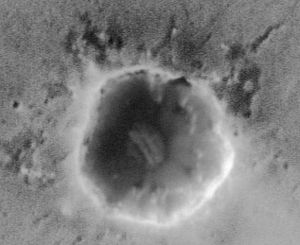Endurance (crater)
|
View of Endurance from orbit.
|
|
| Planet | Mars |
|---|---|
| Region | Meridiani Planum |
| Coordinates | 1°54′S 354°30′E / 1.9°S 354.5°ECoordinates: 1°54′S 354°30′E / 1.9°S 354.5°E |
| Diameter | 130 m |
| Depth | Approx. 20 m (66 ft) |
| Discoverer | Opportunity rover |
| Eponym | The ship Endurance |
Endurance is an impact crater lying situated within the Margaritifer Sinus quadrangle (MC-19) region of the planet Mars. This crater was visited by the Opportunity rover from May until December 2004. Mission scientists named the crater after the ship Endurance that sailed to the Antarctic through the Weddell Sea during the ill-fated 1914-1917 Imperial Trans-Antarctic Expedition, considered to be the last expedition of the Heroic Age of Antarctic Exploration organized by Ernest Shackleton.
The rover entered the crater interior on its 134th mission sol (June 15), and exited on the 315th sol (December 14). During this time it traversed various obstacles, steep inclines, and overcame large wheel slippage when driving over fine sand.
After arriving at the crater, Opportunity performed a survey of the crater to plan the further steps in exploring the local geology. A site dubbed "Karatepe" was chosen to enter the crater and investigate the layering of the bedrock.
The picture to the right shows changes in the color of the bedrock layers. The layer "A" is closer to the rover and higher than the layers "B" to "E". Texture and rock chemistry also differed with depth. Thus scientists infer that the age of these layers is following a similar pattern, with the higher layers being younger than the lower layers.
Opportunity then went farther down into the crater to investigate the sand dunes. Various rock outcrops were investigated while the rover descended. It was decided not to drive into the dunes, for fear the rover might get stuck permanently. Instead, Opportunity did some work on some rocks surrounding the dunes before heading back up to the rim of the crater. On the way, it encountered a boulder, nicknamed 'Wopmay', that provided inconclusive evidence that rocks near the bottom of the crater were affected by water before and after the crater formed.
...
Wikipedia

